DC Microgrid Utilizing Artificial Intelligence and Phasor Measurement Unit Assisted Inverter
Abstract
1. Discussion
1.1. Initial Synchronization of DC Microgrid with the Utility’s AC Grid
1.2. Slip Management during Connected Mode Operation
1.3. Production of Distortion-Free, Pure Sine Wave
2. Proposed Approach in View of Prior Art
- (i)
- Initial synchronization with the utility grid,
- (ii)
- Instantaneous slip management during operation, and
- (iii)
- Distortions produced by the inverter electronics.
- (i)
- A new “PMU Assisted Inverter (PAI)” for DC microgrids is proposed. The proposed inverter is designed to continually receive real-time PMU data from the utility’s network about the utility grid’s AC voltage characteristics (magnitude, frequency, and phase).
- (ii)
- A new “Reference Signal Generator” is devised for the proposed inverter. It continuously uses the PMU data and produces the reference signal for the inverter. Therefore, the characteristics (magnitude, frequency, and phase angle) of the reference signal keep changing in real time according to the characteristics of the grid’s voltage. Thus, the inverter output signal, which is a function of the reference signal, closely mimics the utility grid’s AC voltage. Since the proposed inverter produces the output signal that closely mimics the grid’s voltage, it helps the DC grid achieve a graceful initial synchronization with the utility grid.
- (iii)
- Since the utility grid’s frequency varies due to the unpredictable load variations, it may result in slips or frequency oscillations. If slips are not managed, the system may fall out of synchronization. A new “Pulse Width Modulator (PWM)” is designed for the proposed inverter. Since the modulating signal’s frequency follows the grid’s frequency, the output frequency of the inverter stays synchronized with the grid frequency, which helps the DC grid mitigate the slips or frequency oscillations during the connected operation.
- (iv)
- Since the inverter uses an Insulated Gate Bipolar Transistor (IGBT), the non-ideal characteristics of the IGBT distort the AC waveform each time it crosses zero voltage and hence it is called Zero Crossovers Distortions. Compensation to these distortions requires the width of the PWM signal to be adjusted in each switching cycle. A new “Distortion Observer and Controller” is designed for the proposed inverter. The distortion observer also uses the reference signal from the above noted reference signal generator to adjust the pulse width in real time. It helps the DC grid mitigate the zero crossover distortions.
- (v)
- A “Policy Manager” is also proposed, and its algorithm is designed to manage the community based DC sources, i.e., rooftop solar panels and the residents’ EVs, connected to a community battery bank. The policy manager is installed with an energy meter to measure the energy pooled into, or used from the community battery bank, and the depreciation of the contributing resources. The policy manager also schedules the discharging/recharging of the EV batteries.
- (vi)
- An Artificial Intelligence (AI) based smart client is also proposed that sits in the microgrid. It is programed to communicate with the utility company’s network to fetch the PMU data and forward it to the proposed inverter (i.e., reference signal generator) in real-time. A policy algorithm for the Smart client is also designed that makes smart decisions, as explained in some other sections. To validate the concept, a novel intelligent DC microgrid architecture is also proposed. It is novel because it employs (a) the proposed PMU Assisted Inverter (PAI), (b) the cloud-based Artificial Intelligence (AI), and (c) the community-based DC microgrid that harnesses energy from grid-connected Electrical Vehicles’ (EVs) batteries and the community’s rooftop solar resources.
3. Description of Proposed Work
3.1. PMU Assisted Inverter (PAI)
3.2. DC Microgrid
3.3. Communication Network
4. Test Cases Based on Simulation and Mathematical Analysis
4.1. Inverter Output
4.2. Synchronization
4.3. Distortion Mitigation
4.4. Inverter Efficiency
4.5. Efficiency of Battery Bank Managed by Policy Manager and Smart Client
4.6. Summary of Test Cases
5. Conclusions
6. Future Work
Author Contributions
Funding
Institutional Review Board Statement
Conflicts of Interest
References
- Palaniappan, K. A Viable Residential DC Microgrid for Low-Income Communities—Architecture, Protection and Education. Ph.D. Thesis, University of Wisconsin-Milwaukee, Milwaukee, WI, USA, 2019. Available online: https://dc.uwm.edu/cgi/viewcontent.cgi?referer=&httpsredir=1&article=3238&context=etd (accessed on 4 May 2021).
- Cho, C.; Jeon, J.-H.; Kim, J.-Y.; Kwon, S.; Park, K.; Kim, S. Active synchronizing control of a microgrid. IEEE Trans. Power Electron. 2011, 26, 3707–3719. [Google Scholar] [CrossRef]
- Shaaban, A.; Thomas, J.; Mostafa, R. Design and implementation of a single-phase spwm inverter based microcontroller for wind energy conversion systems. Int. J. Syst. Appl. Eng. Dev. 2017, 11, 291–296. [Google Scholar]
- Spitsa, V.; Kuperman, A.; Weiss, G.; Rabinovici, R. Design of a robust voltage controller for an induction generator in an autonomous power system using a genetic algorithm. In Proceedings of the American Control Conference, Minneapolis, MI, USA, 14–16 June 2006; pp. 3475–3481. [Google Scholar]
- Souza, W.A.D.; Teixeira, M.C.M.; Santim, M.P.A.; Cardim, R.; Assunção, E. Robust switched control. Design for nonlinear systems using fuzzy models. In Mathematical Problems in Engineering; Hindawi Publishing Co.: London, UK, 2014. [Google Scholar]
- Evanczuk, S. Synchronizing Small-Scale PV Systems with the Grid—Last Modified in September 2015. Available online: https://www.digikey.com/en/articles/synchronizing-small-scale-pv-systems-with-the-grid (accessed on 4 May 2021).
- Fuad, K.S.; Hossain, E. Performance of grid-voltage synchronization algorithms based on frequency-and phase-locked loop during severe grid fault conditions. In Proceedings of the 3rd International Conference on Electrical Engineering and In-formation Communication Technology (ICEEICT), Dhaka, Bangladesh, 22–24 September 2016. [Google Scholar] [CrossRef]
- Teodorescu, R.; Liserre, M.; Rodriguez, P. Grid Converters for Photovoltaic and Wind Power Systems; John Wiley & Sons: Hobo-ken, NJ, USA, 2011. [Google Scholar]
- Karimi-Ghartemani, M. Enhanced Phase-Locked Loop Structures for Power and Energy Applications; John Wiley & Sons: Hobo-ken, NJ, USA, 2014. [Google Scholar] [CrossRef]
- Bellini, A.; Bifaretti, S.; Giannini, F. A robust synchronization method for centralized microgrids. IEEE Trans. Ind. Appl. 2015, 51, 1602–1609. [Google Scholar] [CrossRef]
- Giraldo, J.; Mojica-Nava, E.; Quijano, N. Synchronization of isolated microgrids with a communication infrastructure using energy storage systems. Int. J. Electr. Power Energy Syst. 2014, 63, 71–82. [Google Scholar] [CrossRef]
- Ahshan, R.; Saleh, S.A.; Al-Badi, A. Performance analysis of a Dq power flow-based energy storage control system for microgrid applications. IEEE Access 2020, 8, 178706–178721. [Google Scholar] [CrossRef]
- Jin, C.; Gao, M.; Lv, X.; Chen, M. A seamless transfer strategy of islanded and grid-connected mode switching for microgrid based on droop control. In Proceedings of the 2012 IEEE Energy Conversion Congress and Exposition (ECCE), Raleigh, NC, USA, 15–20 September 2012; pp. 969–973. [Google Scholar]
- Begovic, M.M.; Djuric, P.M.; Dunlap, S.; Phadke, A.G. Frequency tracking in power networks in the presence of harmonics. IEEE Trans. Power Deliv. 1993, 8, 480–486. [Google Scholar] [CrossRef]
- Yang, J.-Z.; Liu, C.-W. A precise calculation of power system frequency and phasor. IEEE Trans. Power Deliv. 2000, 15, 494–499. [Google Scholar] [CrossRef]
- Cho, C.; Kim, S.-K.; Jeon, J.-H.; Kim, S. New ideas for a soft synchronizer applied to CHP cogeneration. IEEE Trans. Power Deliv. 2010, 26, 11–21. [Google Scholar] [CrossRef]
- Choi, J.-W.; Sul, S.-K. New dead time compensation eliminating zero current clamping in voltage-fed PWM inverter. In Proceedings of the 1994 IEEE Industry Applications Society Annual Meeting, Denver, CO, USA, 2–6 October 1994; Volume 2, pp. 977–984. [Google Scholar]
- Zhang, J.; Fang, L. An accurate approach of dead-time compensation for three-phase DC/AC inverter. In Proceedings of the 2009 4th IEEE Conference on Industrial Electronics and Applications, Xi’an, China, 25–27 May 2009; pp. 2929–2934. [Google Scholar]
- Ji, Y.; Yang, Y.; Zhou, J.; Ding, H.; Guo, X.; Padmanaban, S. Control strategies of mitigating dead-time effect on power converters: An overview. Electronics 2019, 8, 196. [Google Scholar] [CrossRef]
- Zhou, H.W.; Wen, X.H.; Zhao, F.; Zhang, J.; Guo, X.H. A novel adaptive dead-time compensation strategy for VSI. In Zhongguo Dianji Gongcheng Xuebao, Proceedings of the Chinese Society of Electrical Engineering; Chinese Society for Electrical Engineering: Shanghai, China, 2011; pp. 26–32. [Google Scholar]
- Song, C.; Diao, N.; Xue, Z.; Sun, X.; Guan, J. Tri-carrier sinusoidal pulse-width modulation without dead time effects for converters. IET Power Electron. 2015, 8, 1941–1951. [Google Scholar] [CrossRef]
- Ikegami, S.; Hoshi, N.; Haruna, J. Experimental verification of dead-time compensation scheme for pulse width modulation scheme on six-switch two three-phase out put inverter. In Proceedings of the 2014 17th International Conference on Electrical Machines and Systems (ICEMS), Hangzhou, China, 22–25 October 2014; pp. 1420–1424. [Google Scholar]
- Bespal, K.; Savarovsky, V.J.; Stepin, V. Method for measuring pulse width, which is less than the dead-time of measurement instrument. In Proceedings of the 2012 13th Biennial Baltic Electronics Conference, Tallinn, Estonia, 3–5 October 2012; pp. 311–314. [Google Scholar]
- Ogawa, M.; Ogasawara, S.; Takemoto, M. A feedback-type dead-time compensation method for high-frequency PWM inverter delay and pulse width characteristics. In Proceedings of the 2012 Twenty-Seventh Annual IEEE Applied Power Elec-tronics Conference and Exposition (APEC), Orlando, FL, USA, 5–9 February 2012; pp. 100–105. [Google Scholar]
- Weerakoon, D.B.R.; Sandaruwan, B.L.L.; De Silva, R.T.T.; Abeyratne, S.G.; Rathnayake, D.B. A novel dead-time compensation scheme for PWM VSI drives. In Proceedings of the 2016 IEEE International Conference on Information and Automation for Sustainability (ICIAfS), Galle, Sri Lanka, 16–19 December 2016. [Google Scholar]
- Lee, C.-T.; Chu, C.-C.; Cheng, P.-T. A new droop control method for the autonomous operation of distributed energy resource interface converters. IEEE Trans. Power Electron. 2013, 28, 1980–1993. [Google Scholar] [CrossRef]
- Islam, A.S.; Rahman, M.M.; Mondal, M.A.H.; Alam, F. Hybrid energy system for St. Martin island, Bangladesh: An optimized model. Procedia Eng. 2012, 49, 179–188. [Google Scholar] [CrossRef]
- Karimi-Ghartemani, M.; Iravani, M. A method for synchronization of power electronic converters in polluted and variable-frequency environments. IEEE Trans. Power Syst. 2004, 19, 1263–1270. [Google Scholar] [CrossRef]
- Saleh, S.A.; Ahshan, R. Resolution-level-controlled WM inverter for PMG-based wind energy conversion system. IEEE Trans. Ind. Appl. 2012, 48, 750–763. [Google Scholar] [CrossRef]
- Toulabi, M.; Shiroei, M.; Ranjbar, A. Robust analysis and design of power system load frequency control using the Kharitonov’s theorem. Int. J. Electr. Power Energy Syst. 2014, 55, 51–58. [Google Scholar] [CrossRef]
- Kotsopoulos, A.; Heskes, P.J.; Jansen, M.J. Zero-crossing distortion in grid-connected PV inverters. IEEE Trans. Ind. Electron. 2005, 52, 558–565. [Google Scholar] [CrossRef]
- Dotta, D.; Chow, J.H.; Vanfretti, L.; Almas, M.S.; Agostini, M.N. A MATLAB-based PMU simulator. In Proceedings of the IEEE Conference on Power and Energy Society General Meeting (PES), Vancouver, BC, Canada, 21–25 July 2013. [Google Scholar] [CrossRef][Green Version]
- Yaqub, R.; Tariq, A.; Cao, Y. A smart solution for fair value compensation (FVC) in EV-batteries based mobile microgrid. In Proceedings of the 10th International Conference on Frontiers of Information Technology, Islamabad, Pakistan, 17–19 December 2012. [Google Scholar]
- King, D. The Regulatory Environment for Interconnected Electric Power Micro-Grids: Insights from State Regulatory Officials. Rep. CEIC-05-08. 2005. Available online: https://www.cmu.edu/ceic/assets/docs/publications/working-papers/ceic-05-08.pdf (accessed on 16 June 2021).
- AutoML Vision API Tutorial. Available online: cloud.google.com/vision/automl/docs/tutorial (accessed on 16 June 2021).
- Antonopoulos, I.; Robu, V.; Couraud, B.; Kirli, D.; Norbu, S.; Kiprakis, A.; Flynn, D.; Elizondo-Gonzalez, S.; Wattam, S. Artificial intelligence and machine learning approaches to energy demand-side response: A systematic review. Renew. Sustain. Energy Rev. 2020, 130, 109899. [Google Scholar] [CrossRef]
- Nguyen, M.H.; Becan, A.F.; Harvey, B.W. Active Filtering Using Wind Turbine Generator. Ph.D. Thesis, Worcester Polytechnic Institute (WPI), Worcester, MA, USA, April 2015. [Google Scholar]
- Synchronizing and Synchronizing Equipment. Available online: www.o-t-s.com/synchronizing.htm (accessed on 13 December 2020).
- An Industry and National Laboratory Collaborative to Improve Photovoltaic Performance Modeling. Available online: https://pvpmc.sandia.gov/modeling-steps/dc-to-ac-conversion/cec-inverter-test-protocol/ (accessed on 13 December 2020).
- INVADE. Smart System of Renewable Energy Storage Based on Integrated EVS and Batteries to Empower Mobile, Distributed and Centralised Energy Storage in the Distribution Grid. Available online: h2020invade.eu/wp-content/uploads/2017/06/D6.2-Battery-techno-economics-tool.pdf (accessed on 4 May 2021).
- Unamuno, E.; Barrena, J.A. Hybrid ac/dc microgrids—Part I: Review and classification of topologies. Renew. Sustain. Energy Rev. 2015, 52, 1251–1259. [Google Scholar] [CrossRef]
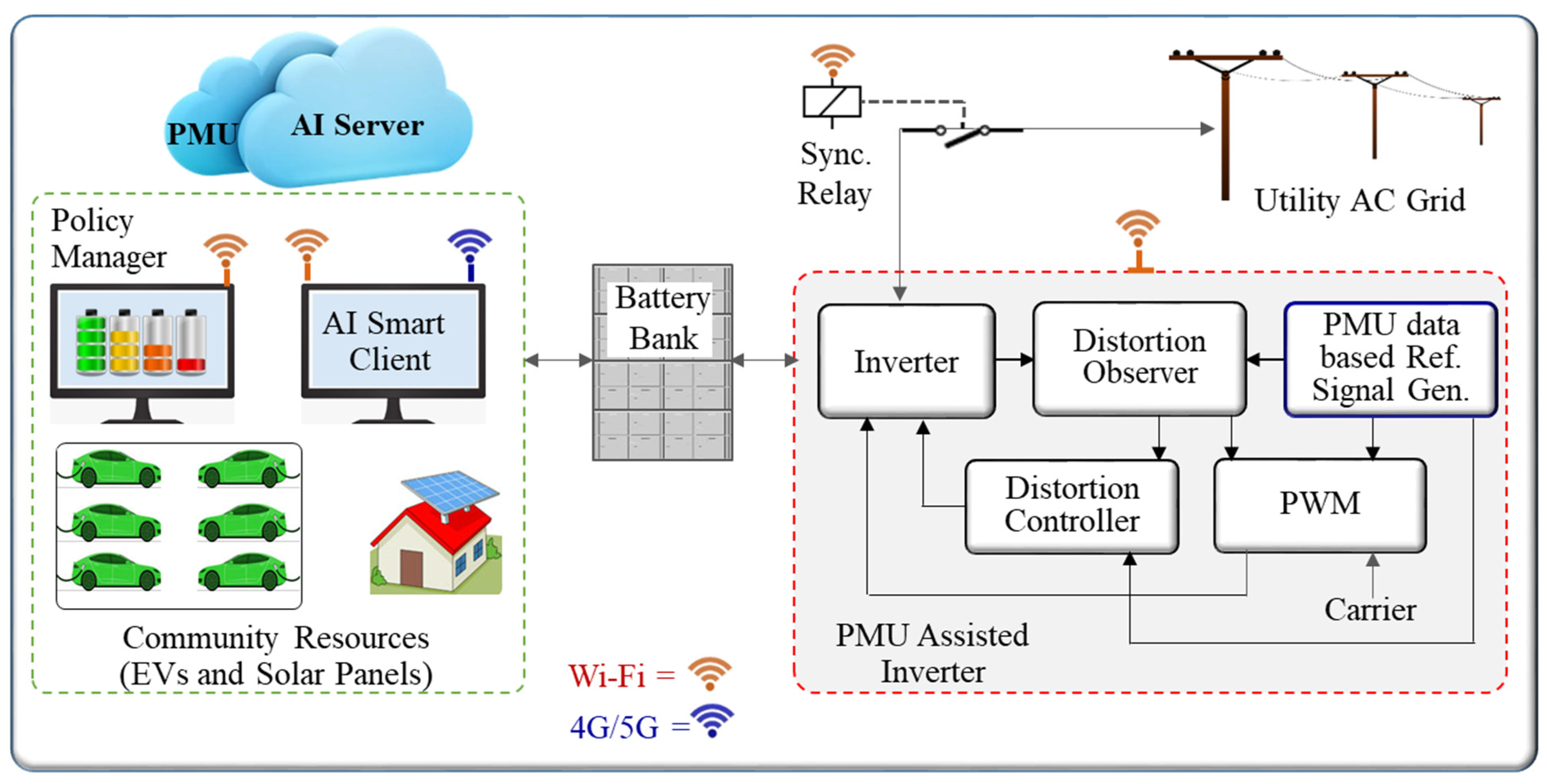
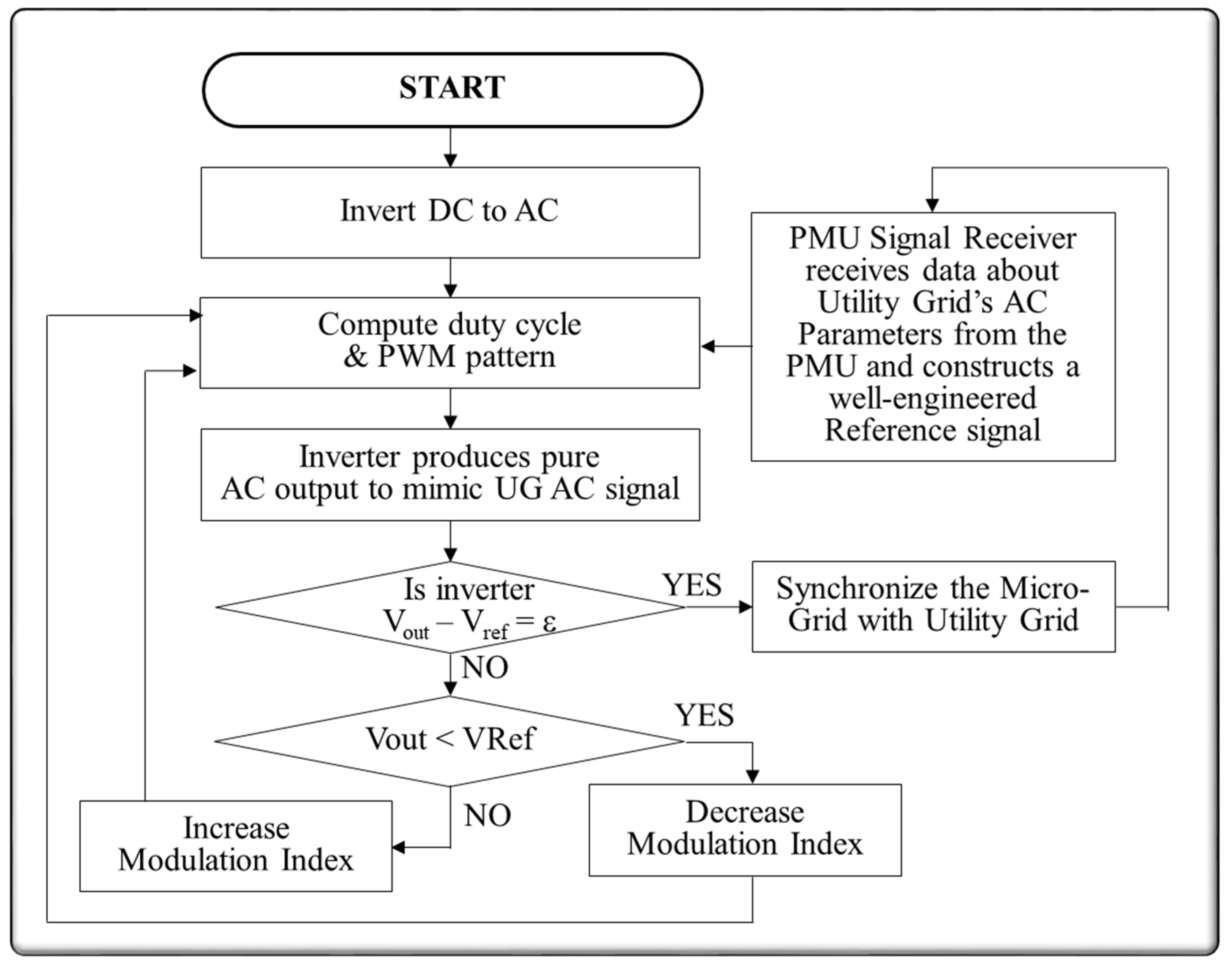
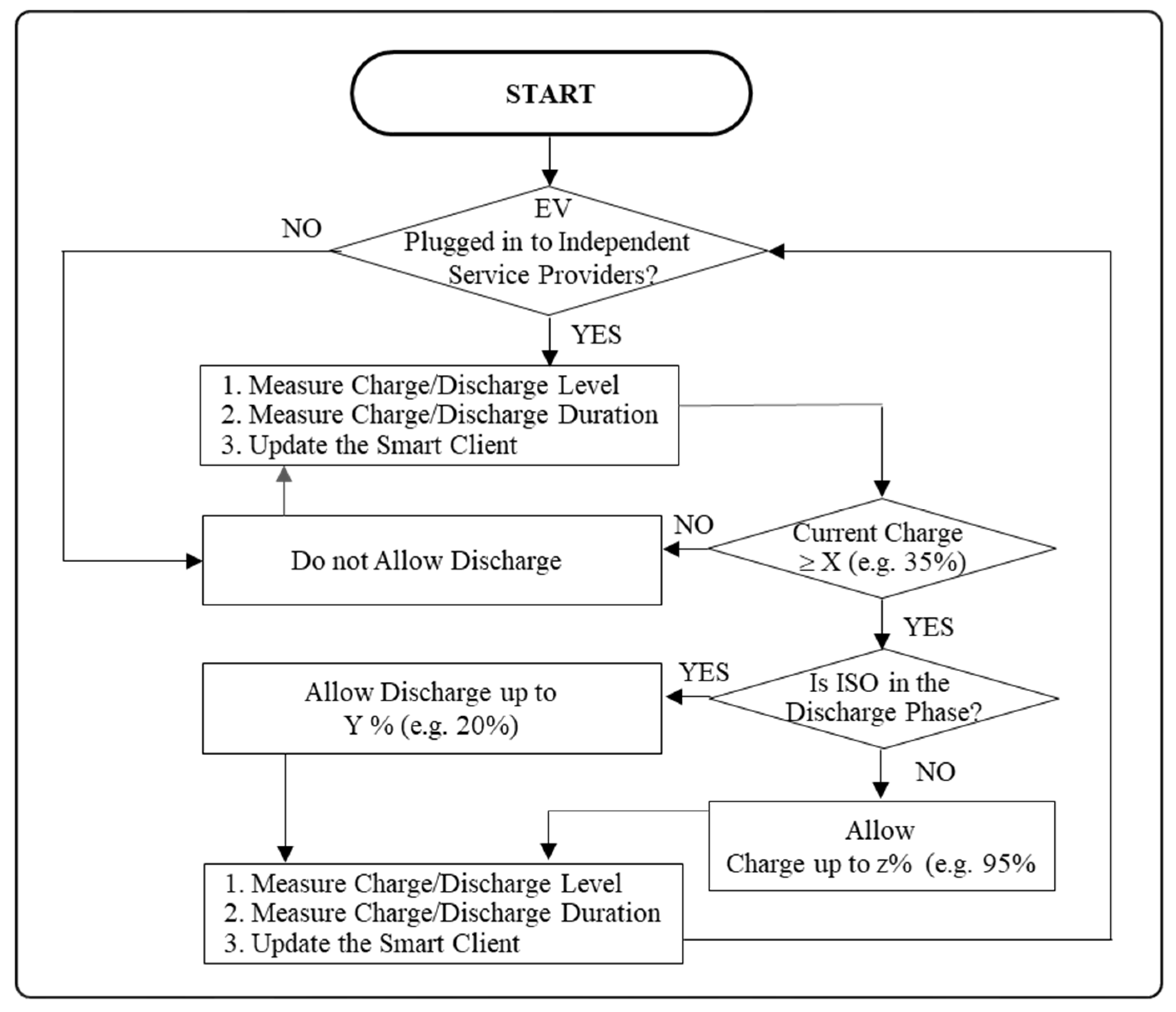
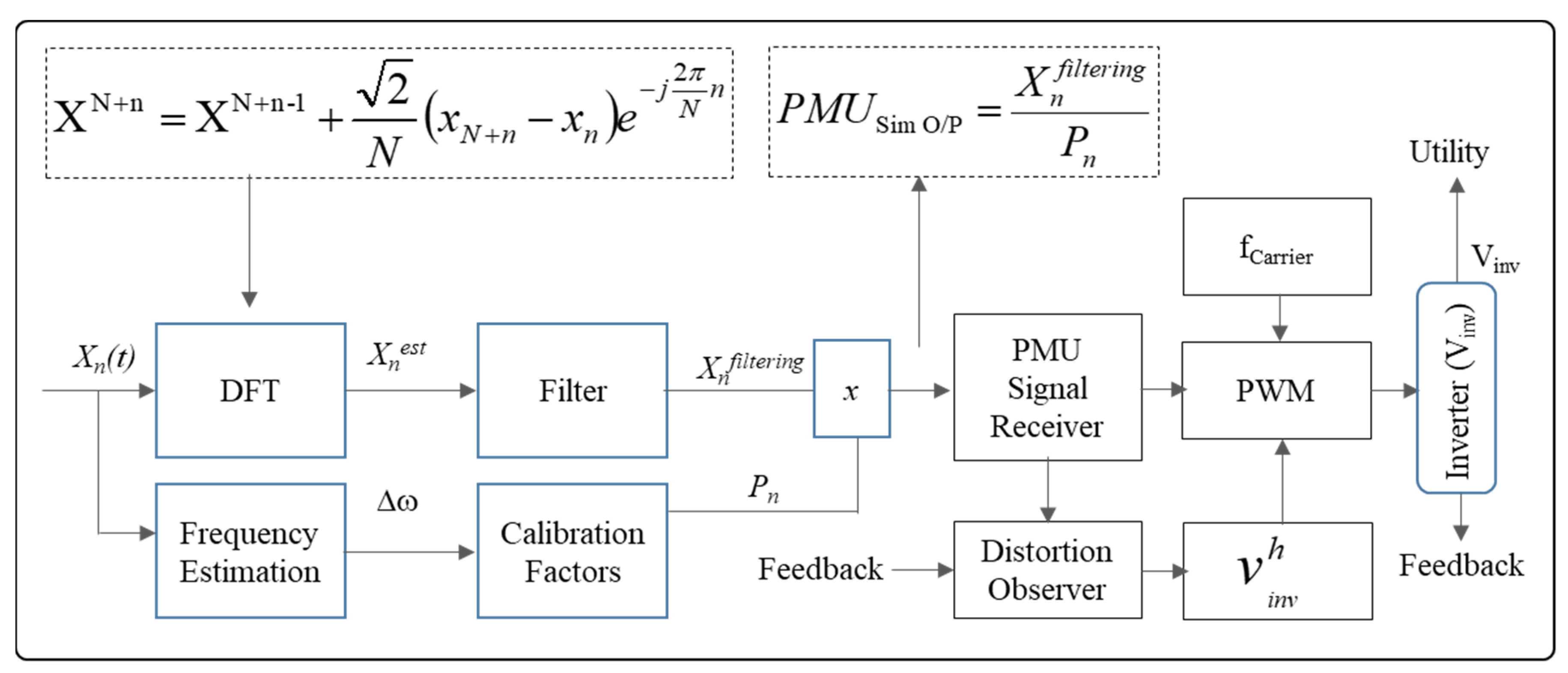

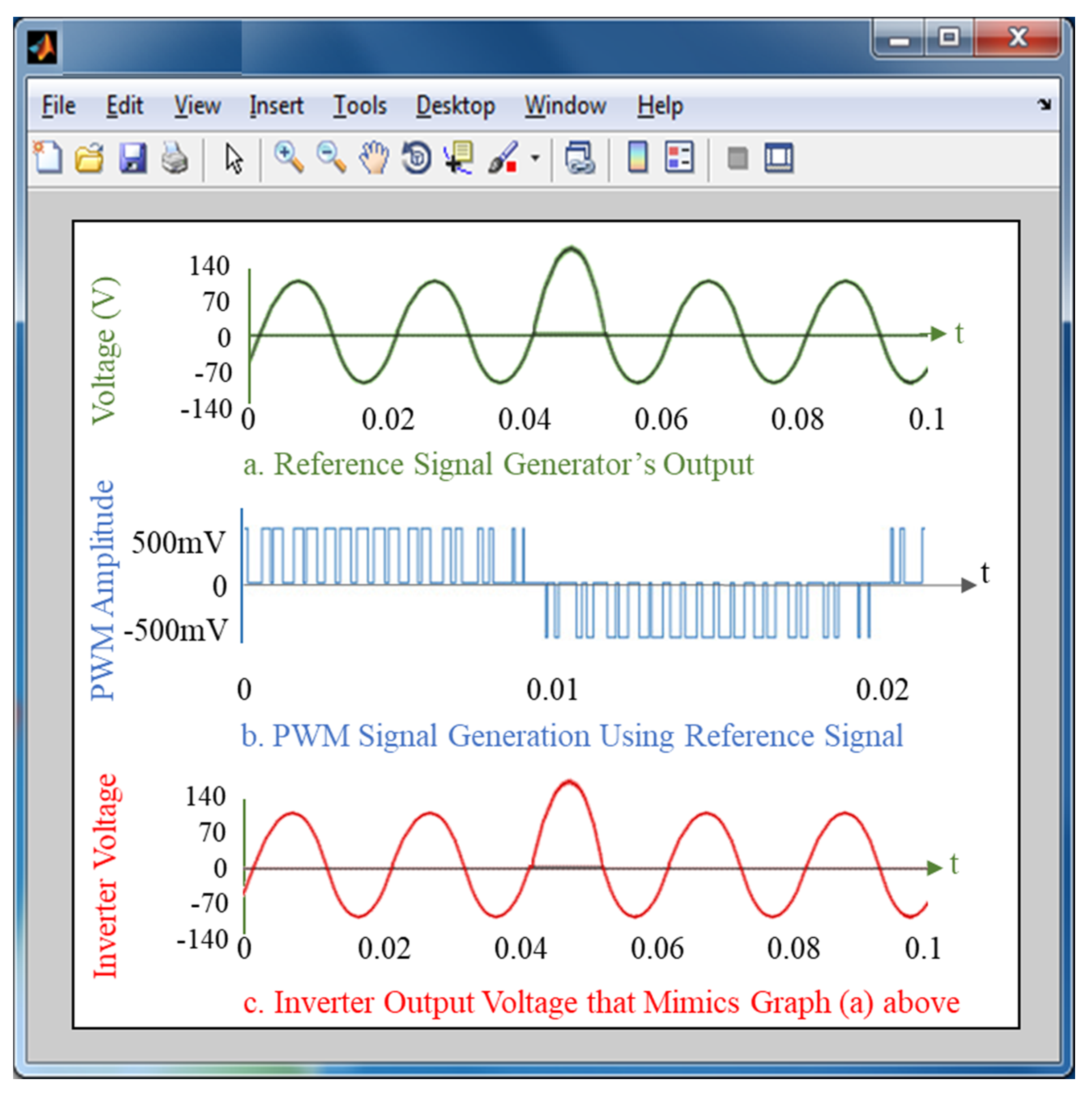
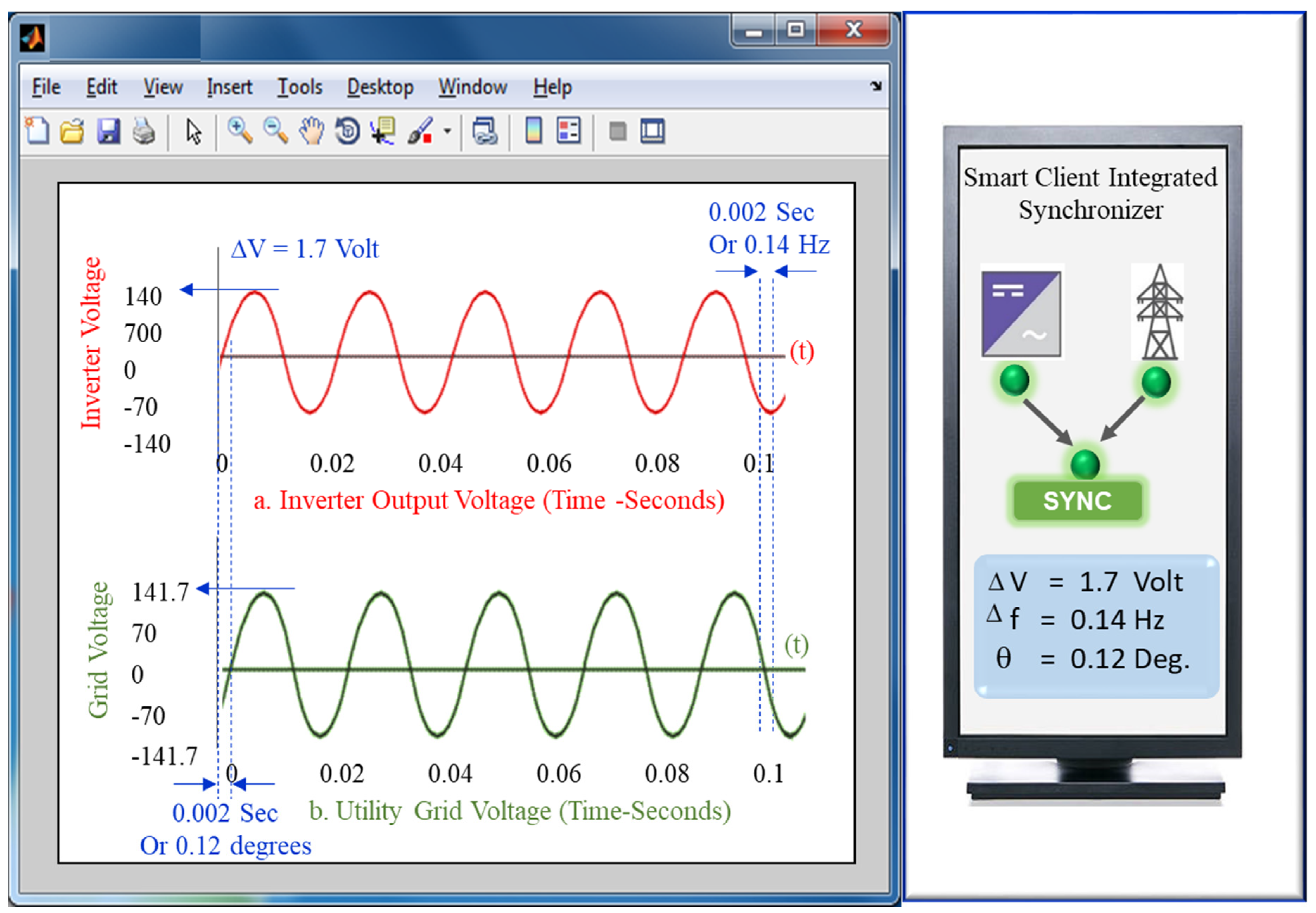
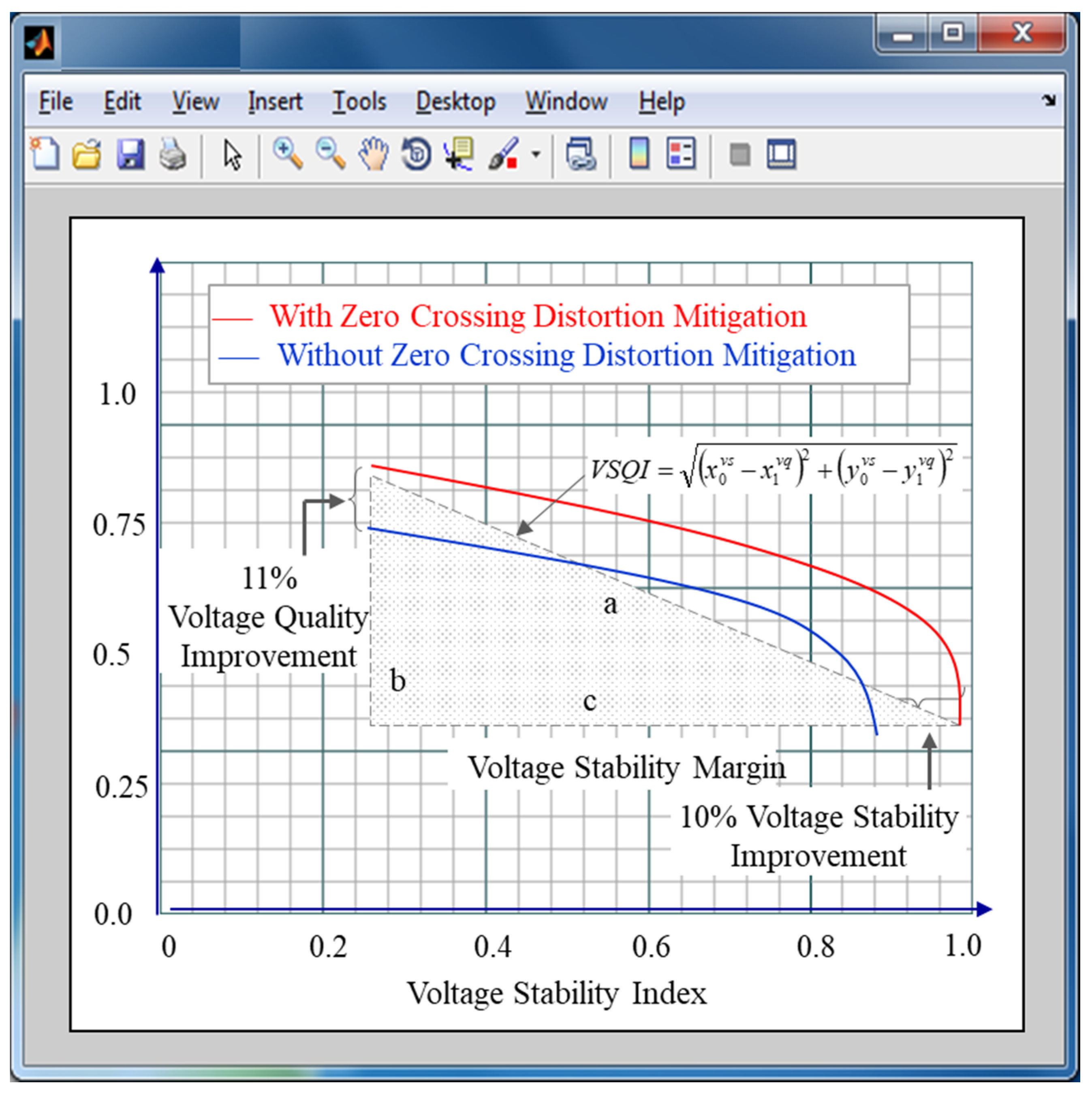

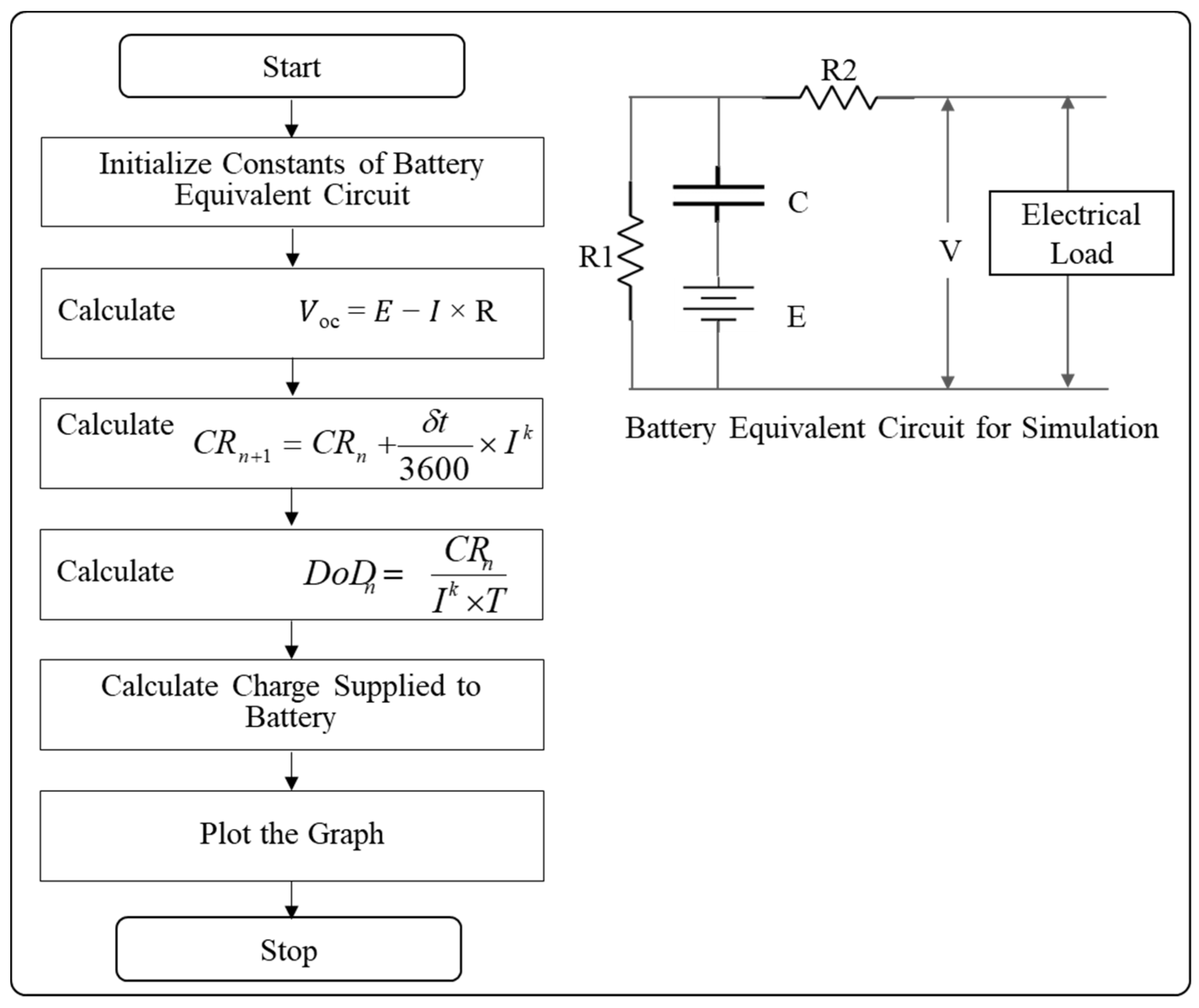

| Features | Reference No. |
|---|---|
| Synchronization | [2,6,7,10,11,13,14,16,28] |
| Slip Mismanagement | [6,7,13,14,15,17,24,28,30] |
| Distortion Mitigation | [5,7,14,15,17,18,19,20,25,31] |
| Integrated Synchronization + Slip Mismanagement + Distortion Mitigation | Proposed only |
| PMU based Simulator | [32] |
| Real Time PMU based Assisted Inverter | Proposed |
| Reference Signal Generator for Inverter | [1,3,6,7,14] |
| PMU Data based reference Signal Generator | Proposed only |
| Pulse Width Modulator (PWM) | [4,13,14,21,22,23,24,25] |
| Pulse Width Modulator (PWM) that follows grid frequency | Proposed |
| Zero Crossover Distortion Mitigation | [17,18,20,21,22] |
| Zero Crossover Distortion Mitigation based on PMU Data | Proposed |
| AI, PMU based DC Micro-grid | Proposed |
| Policy Manager based Community resources shared DC Micro-grid | Proposed |
Publisher’s Note: MDPI stays neutral with regard to jurisdictional claims in published maps and institutional affiliations. |
© 2021 by the authors. Licensee MDPI, Basel, Switzerland. This article is an open access article distributed under the terms and conditions of the Creative Commons Attribution (CC BY) license (https://creativecommons.org/licenses/by/4.0/).
Share and Cite
Yaqub, R.; Ali, M.; Ali, H. DC Microgrid Utilizing Artificial Intelligence and Phasor Measurement Unit Assisted Inverter. Energies 2021, 14, 6086. https://doi.org/10.3390/en14196086
Yaqub R, Ali M, Ali H. DC Microgrid Utilizing Artificial Intelligence and Phasor Measurement Unit Assisted Inverter. Energies. 2021; 14(19):6086. https://doi.org/10.3390/en14196086
Chicago/Turabian StyleYaqub, Raziq, Mohamed Ali, and Hassan Ali. 2021. "DC Microgrid Utilizing Artificial Intelligence and Phasor Measurement Unit Assisted Inverter" Energies 14, no. 19: 6086. https://doi.org/10.3390/en14196086
APA StyleYaqub, R., Ali, M., & Ali, H. (2021). DC Microgrid Utilizing Artificial Intelligence and Phasor Measurement Unit Assisted Inverter. Energies, 14(19), 6086. https://doi.org/10.3390/en14196086







